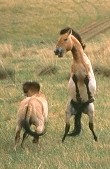Przewalski horse behaviour is  remarkably synchronised in a harem. They all graze and rest at the same time. When some of the horses start to nibble one another, the others will follow suit. Frolicsome foals or rolling older ones instantly invite others to join in with the fun. Skin care is very important. They like to scratch themselves against rocky surfaces, shrubs or to roll in the sand. Yet, they cannot reach their own backs. The help of others is needed. Standing head to tail they nibble one another’s skin. This is called mutual grooming, which not only has a pure practical function, but also furthers mutual bonding and works as a stress relief for the whole group.
remarkably synchronised in a harem. They all graze and rest at the same time. When some of the horses start to nibble one another, the others will follow suit. Frolicsome foals or rolling older ones instantly invite others to join in with the fun. Skin care is very important. They like to scratch themselves against rocky surfaces, shrubs or to roll in the sand. Yet, they cannot reach their own backs. The help of others is needed. Standing head to tail they nibble one another’s skin. This is called mutual grooming, which not only has a pure practical function, but also furthers mutual bonding and works as a stress relief for the whole group.
Dominance hierarchy is essential for the ordering of social contacts. While social hierarchy ascertained each individual knows his position in the group, which leads to lesser aggression and to more harmony. Internal fighting results in a loss of energy and increases the chance of getting wounded. Survival in the wild requires much energy. Wounds attract parasites and can be the cause of dangerous if not lethal infections.
The leading stallion is often the most dominant one in a harem, followed in this order by the mares and the younger members in the group. The older and most aggressive mares rank highest in the hierarchy. The stallion expresses his top rank position by herding his mares, using a characteristic ‘ snaking’ posture with his head held low and ears flat back. The mares set their mutual disputes by lowering their ears in the neck and intimidating the other with bite threats or kicks with the hind legs.
The Przewalski horses at Hustai National Park display less aggressiveness to one another than their congenitors in captivity do. Here there is plenty of space to be able to side-step from conflict. Young stallions can move out of sight from the native groups from which their fathers expelled them. In this manner they will avoid renewed aggression from their fathers. In zoos they cannot run away.
A harem stallion marks the urine and droppings of his mares with his own. In this way he not only communicates to other stallions that this are his mares, but also finds out whether a mare is in heat or not.
Dung piles serve a different cause. There will certainly be more of them alongside the most popular migrating routes when there are more Przewalski groups in the area. Communal dung piles are a means of communication between the different harem stallions. By marking it with his own dung a stallion signals his presence. A passing stallions ‘reads’ the pile in a ritualised manner by sniffing the scent, walking over it, dropping his own dung and finally sniffing his own freshly deposited scent markings. In this way the stallion learns whether other stallions did pass this spot recently or did so at an earlier moment. The dung piles accomplish not only a social function in the contacts between the various groups, but they also function as some kind of orientation mark.
 An encounter between two leading stallions takes also a ritualised course. The two dash into each other. Once they are close, they approach one another with crested necks and sniff noses. Mostly this will elicit a squeal and one or both may strike out with a front leg. Thereafter they sniff at each other’s genitals and noses. When a fight seems unavoidable, the opponents will rear and box with their front legs and bite one another fiercely in the flanks and legs. The hostilities will go on until the weaker party is chased away and the victor has rejoined his mares. However, most encounters between family stallions rarely end in violence. Encounters with mature bachelor stallions are far more hostile. Such confrontations are very violent and often lead to severe injury. In the course of many encounters the stallions learn to respect each other’s force. This helps them to decide whether they should avoid a particular harem stallion or just take the chance to dispute a drinking place or even mares.
An encounter between two leading stallions takes also a ritualised course. The two dash into each other. Once they are close, they approach one another with crested necks and sniff noses. Mostly this will elicit a squeal and one or both may strike out with a front leg. Thereafter they sniff at each other’s genitals and noses. When a fight seems unavoidable, the opponents will rear and box with their front legs and bite one another fiercely in the flanks and legs. The hostilities will go on until the weaker party is chased away and the victor has rejoined his mares. However, most encounters between family stallions rarely end in violence. Encounters with mature bachelor stallions are far more hostile. Such confrontations are very violent and often lead to severe injury. In the course of many encounters the stallions learn to respect each other’s force. This helps them to decide whether they should avoid a particular harem stallion or just take the chance to dispute a drinking place or even mares.
